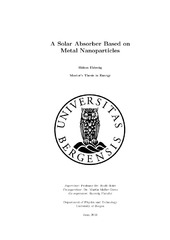A Solar Absorber Based on Metal Nanoparticles
Master thesis
Permanent lenke
https://hdl.handle.net/1956/12617Utgivelsesdato
2016-06-01Metadata
Vis full innførselSamlinger
- Geophysical Institute [1198]
Sammendrag
Metal nanoparticles (MNPs) exhibits unique optical properties often found in the visible spectrum of light. The key point of interest is the so-called Localized Surface Plasmon Resonance (LSPR) effect that arises within particles exposed to electromagnetic radiation. An increase in scattering and absorption of light can be seen for specific wavelengths of incident electromagnetic radiation due to the LSPR effect. Through tuning of the nanoparticle size, shape, interparticle distance and metal, the LSPR wavelength and absorption spectra for the MNPs can be manipulated. However, a solar absorber purely based on MNPs and their LSPR has not been designed yet. In this work a suitable basis is shown for making solar absorbers solely based on individual MNPs and a design for the solar absorber is presented. The LSPR wavelengths dependency on particle size, shape and metal were confirmed through a series of experiments. Gold and aluminium MNP arrays consisting of decoupled particles with diameters in the range of 40 nm - 200 nm were fabricated by the means of electron beam lithography. In addition, mixed arrays consisting of particles with varying sizes and metals were fabricated. The extinction and absorption spectra measured from the MNP arrays were found to match published literature. The optical analyses of the arrays revealed that the maximum extinction is highly dependent on surface coverage. In addition to the fact that the peak position can be fine-tuned by changing the particle diameter. It was also found that aluminium has a broader extinction peak than gold, making it an ideal candidate for broad band light absorption. Our results demonstrate how MNPs can be used to design a solar absorber, which could absorb over a larger spectrum than conventional solar energy converters. The work done in this thesis provides a foundation for further research and optimization of MNPs in solar absorbers.
